Kingdom Animalia Order Artiodactyla Scientific name Platanista gangetica Higher classification Platanista | Phylum Chordata Rank Species | |
 | ||
Family PlatanistidaeGray, 1846 Genus PlatanistaWagler, 1830 Similar River dolphin, Indus river dolphin, Platanista, Mammal, La Plata dolphin | ||
The South Asian river dolphin (Platanista gangetica) is a freshwater or river dolphin found in India, Bangladesh, Nepal and Pakistan which is split into two subspecies, the Ganges river dolphin (P. g. gangetica) and Indus river dolphin (P. g. minor). The Ganges river dolphin is primarily found in the Ganges and Brahmaputra Rivers and their tributaries in Bangladesh, India and Nepal, while the Indus river dolphin is found in the Indus River in Pakistan and its Beas and Sutlej tributaries. From the 1970s until 1998, they were regarded as separate species; however, in 1998, their classification was changed from two separate species to subspecies of a single species (see taxonomy below). The Ganges river dolphin has been recognized by the government of India as its National Aquatic Animal. The Indus river dolphin has been named as the National Mammal of Pakistan. Further, the Gangetic river dolphin has been elected to be the city animal of the Indian city of Guwahati.
Contents
- Taxonomy
- Description
- Distribution and habitat
- Biology
- Conservation
- Human interaction
- Non human personhood
- References

Taxonomy
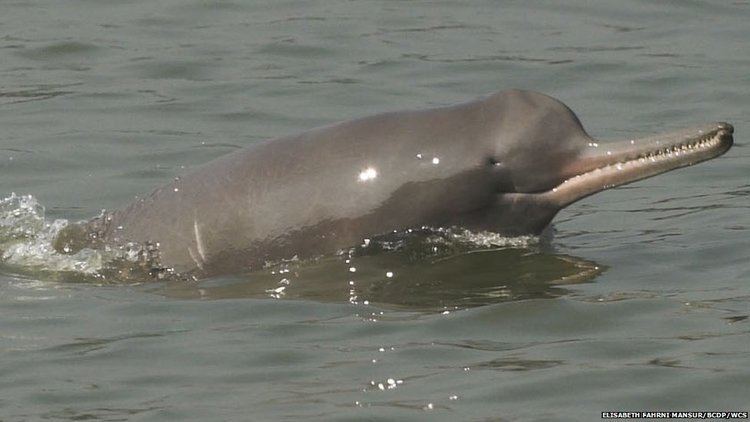
The species was described by two separate authors, Lebeck and Roxburgh, in 1801, and it is unclear to whom the original description should be ascribed. Until the 1970s, the South Asian river dolphin was regarded as a single species. The two subspecies are geographically separate and have not interbred for many hundreds if not thousands of years. Based on differences in skull structure, vertebrae and lipid composition scientists declared the two populations as separate species in the early 1970s. In 1998, the results of these studies were questioned and the classification reverted to the pre-1970 consensus of a single species containing two subspecies until the taxonomy could be resolved using modern techniques such as molecular sequencing. The latest analyses of mitochondrial DNA of the two subspecies did not display the variances needed to support their classification as separate species. Thus, at present, this one species with two subspecies is recognized in the genus Platanista, the P. g. gangetica (Ganges river dolphin) and the P. g. minor (Indus river dolphin).
Description
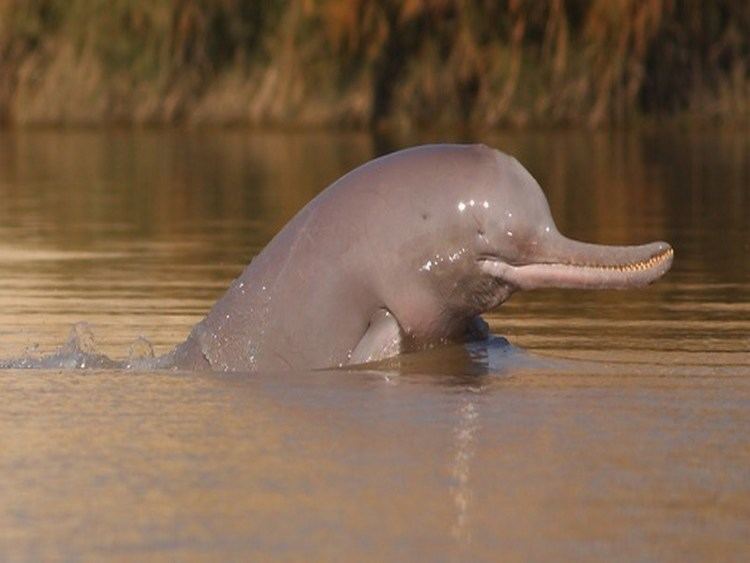
The South Asian river dolphin has the long, pointed nose characteristic of all river dolphins. Its teeth are visible in both the upper and lower jaws even when the mouth is closed. The teeth of young animals are almost an inch long, thin and curved; however, as animals age, the teeth undergo considerable changes and in mature adults become square, bony, flat disks. The snout thickens towards its end. The species does not have a crystalline eye lens, rendering it effectively blind, although it may still be able to detect the intensity and direction of light. Navigation and hunting are carried out using echolocation. They are unique among cetaceans in that they swim on their sides. The body is a brownish color and stocky at the middle. The species has only a small, triangular lump in the place of a dorsal fin. The flippers and tail are thin and large in relation to the body size, which is about 2-2.2 meters in males and 2.4-2.6 m in females. The oldest recorded animal was a 28-year-old male, 199 cm in length. Mature females are larger than males. Sexual dimorphism is expressed after females reach about 150 cm (59 in); the female rostrum continues to grow after the male rostrum stops growing, eventually reaching approximately 20 cm (7.9 in) longer.
Distribution and habitat
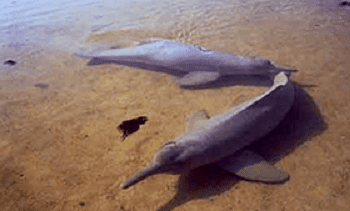
The South Asian river dolphins are native to the freshwater river systems located in Nepal, India, Bangladesh, and Pakistan. They can be most commonly found in water with high abundance of prey and reduced flow.
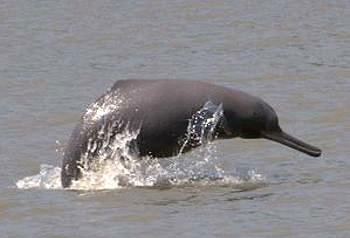
The Ganges subspecies (P. g. gangetica) can be found along the Ganges-Brahmaputra-Meghna and Karnaphuli-Sangu river systems of Bangladesh and India, although its range formerly extended to Nepal. A small subpopulation can be still found on the Ghaghara River and possibly the Sapta Kosi River. The majority of the Indus subspecies (P. g. minor) is located between the Sukkur and Guddu barrage in the Sind Province of Pakistan. Two smaller subpopulations have also been recorded in the Punjab and Khyber Pakhtunkhwa Provinces. Since the two river systems are not connected in any way, it is a mystery how these sub-species ended up in the two rivers. It is improbable that the river dolphins made it from one river to another through the sea route since the two estuaries are very far apart. According to Land of the Seven Rivers: A Brief History of India's Geography by Sanjeev Sanyal, a likely explanation is that several north Indian rivers like the Sutlej and Yamuna changed their path in ancient times and carried the dolphins with them.
Biology
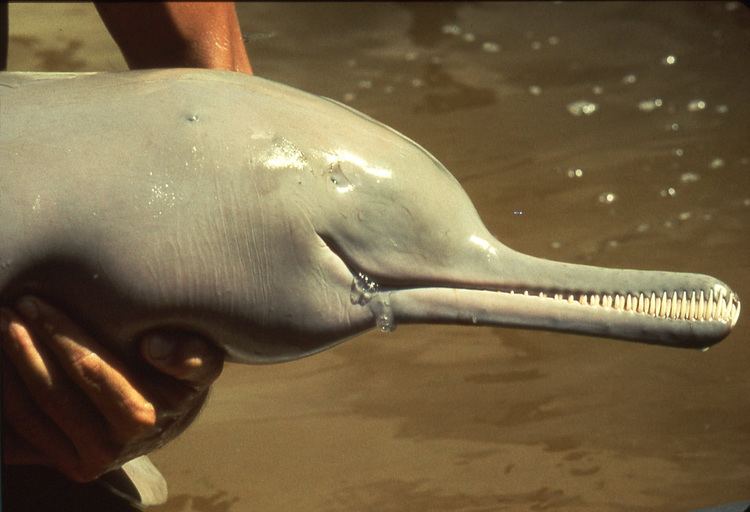
Births may take place year round, but appear to be concentrated between December to January and March to May. Gestation is thought to be approximately 9–10 months. After around one year, juveniles are weaned and they reach sexual maturity at about 10 years of age. During the monsoon, South Asian river dolphins tend to migrate to tributaries of the main river systems. Occasionally, individuals swim along with their beaks emerging from the water, and they may "breach"; jumping partly or completely clear of the water and landing on their sides.
The South Asian river dolphin feeds on a variety of shrimp and fish, including carp and catfish. They are usually encountered on their own or in loose aggregations; the dolphins do not form tight interacting groups.
Conservation
International trade is prohibited by the listing of the South Asian river dolphin on Appendix I of the Convention on International Trade in Endangered Species (CITES). It is protected under the Indian Wildlife Act, although these legislations require stricter enforcement.
Both subspecies are listed by the IUCN as endangered on their Red List of Threatened Species. The Indus river dolphin is listed as endangered by the US government National Marine Fisheries Service under the Endangered Species Act. On a positive note, in recent years, the population of blind Indus dolphins in Pakistan has increased.
The immediate danger for the resident population of P. gangeticus in National Chambal Sanctuary is the decrease in river depth and appearance of sand bars dividing the river course into smaller segments. The proposed conservation measures include designated dolphin sanctuaries and the creation of additional habitat.
Ministry of Environment and Forest declared Gangetic dolphin as national aquatic animal of India. Also, a stretch of Ganges river between Sultanganj and Kahlgaon in Bihar has been declared as dolphin sanctuary and named Vikramshila Gangetic Dolphin Sanctuary (VGDS). It is the world's first dolphin sanctuary for the conservation of Gangetic Dolphin P. Gangeticus.
The species is listed on Appendix I and Appendix II of the Convention on the Conservation of Migratory Species of Wild Animals (CMS). It is listed on Appendix I as this species has been categorized as being in danger of extinction throughout all or a significant proportion of their range and CMS Parties strive towards strictly protecting these animals, conserving or restoring the places where they live, mitigating obstacles to migration and controlling other factors that might endanger them. It is listed on Appendix II as it has an unfavourable conservation status or would benefit significantly from international co-operation organised by tailored agreements.
The Uttar Pradesh government in India is bringing up ancient Hindu texts in hopes of raising the community support to save the dolphins from disappearing. One of the lines being versed from Valimiki’s Ramayan, highlighted the force by which the Ganges emerged from Lord Shivji’s locks and along with this force came many species such as animals, fish and the Shishumaar—the dolphin.
Human interaction
Both subspecies have been very adversely affected by human use of the river systems in the subcontinent. Entanglement in fishing nets can cause significant damage to local population numbers. Some individuals are still taken each year and their oil and meat used as a liniment, as an aphrodisiac, and as bait for catfish. Irrigation has lowered water levels throughout both subspecies' ranges. Poisoning of the water supply from industrial and agricultural chemicals may have also contributed to population decline. Perhaps the most significant issue is the building of more than 50 dams along many rivers, causing the segregation of populations and a narrowed gene pool in which dolphins can breed. Currently, three subpopulations of Indus dolphins are considered capable of long-term survival if protected.
Non-human personhood
On 20 May 2013 India’s Ministry of Environment and Forests has declared dolphins as ‘non-human persons’ and as such has forbidden their captivity for entertainment purposes. Some scientists postulate that dolphins and whales are sufficiently intelligent to justify the same ethical considerations as humans. As a consequence in order to keep dolphins in captivity one must provide a legally sufficient reason for their captivity.
